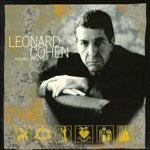Three record reviews: Liz Phair, James Iha, Leonard Cohen
Liz Phair, “whitechocolatespaceegg” reviewed in Maximum Ink (Madison), October 1998
Five years. Life changes. You settle down, have a child. Liz Phair did those things. Some of her fans undoubtedly have too. Yet it’s debatable listening to Phair’s new album, whitechocolatespaceegg, her third, if those extramusical events won’t undermine her musical labors in the eyes and ears of a sizable fan base.
Frank disclosures of sexual misdeeds and misadventure produced on Phair’s two previous records, Exile in Guyville (1993) and Whipsmart (1994), a profane confessional whose salaciousness was tempered by the empathy it induced. A more recent off-record confession found Phair distancing herself from such erstwhile tendencies. “It was more of an art school mentality that led me to say those things anyway,” said Phair, making an admission that may be more revealing than any you’ll find on her new record.
A cursory listen to whitechocolatespaceegg will offer the listener tame, clumsily expressed quotidian detail, coupled with a routine batch of over-ripe hooks and harmony. Is that Liz Phair I hear exorcising some false sense of professional obligation — and half-heartedly at that?
But wait, there could be something here. Is that the chorus of “Ride” still playing in my head? And “Johnny Feelgood,” one has to admit, is a plausible return to the lean, crackling Liz Phair archetype.
Phair could be faulted on Whipsmart for straining too transparently to retain her indie-rock credibility (her use of the f-word was promptly blunted with overuse) in the wake of Exile in Guyville, a record widely reported to be a significant innovation in its field. With whitechocolatespaceegg there is no pretense of any of that. Phair seems content to have fun, to keep things loose, and to bring fans willing to give her slightly less than an hour of their time up to date on her life, regardless of how prosaic the particulars may be.
James Iha “Let Come Down” reviewed in Maximum Ink (Madison), March 1998
As much as James Iha may wish it to be different, comparisons between Smashing Pumpkins and its guitarist’s first solo outing are inevitable, due largely to their utter disparity. Iha seems intent to put as much distance between himself and his band as he possibly can; with Let It Come Down he’s hit upon a formula that meets that aim.
Iha is unabashed in presenting a program of sweet, earnest pop songs, plunging headfirst into the precarious abyss of the heartfelt love song. Strings flow delicately from nearly every song; warm, fuzzy harmonies abound; and Iha’s singing voice, a purer instrument than Pumpkins’ lead singer Billy Corgan’s, is uniquely adept — plausible even — at putting across mawkish lyrics like, “Hallelujah, I’m in love with a girl from the country” and “the sound of love is oceans far away.”
Free of the decadent overstatement and crushing dynamics employed by Smashing Pumpkins, Let It Come Downsucceeds with its faithfulness to a simple design. Iha never strays from that formula, and there seems to be no attempt on his part to make this anything but a nice little record. In so doing he has crafted a tasteful and touching album whose cumulative effect is powerful, if quickly tedious.
Leonard Cohen “More Best Of,” reviewed in The Daily Cardinal, October 29, 1997
Leonard Cohen was most prolific during the 1970s but has enjoyed his widest acclaim and popularity during this decade. Two events seem to have produced this result. First was the release of Cohen’s 1988 album, I’m Your Man, which created the attention — or sufficient curiosity — to generate the tribute disc I’m Your Fan.
Perhaps more important than the Cohen songs presented on that collection was the roster of talent assembled – talent designated for its particular appeal to college radio. REM was given the single and a legend was born, nearly 25 years after Leonard Cohen made his debut as a recording artist.
But Leonard Cohen can’t simply be classified as a performer toiling in obscurity until he was saved by the good graces of Nick Cave and the Pixies. Beginning in 1967 at the ripe old age of 33, Cohen began to amass an impressive collection of recordings, prefiguring Patti Smith as poet-turned-singer and nearly equaling her in influence and esteem.
In recent years, Cohen’s music has been defined by sleek production, backed frugally by keyboard, drums and bass, with the recurring use of an R & B-styled vocal group. His husky purr of a voice and droll, deadpan inflections seem only to improve with the years. Cohen’s 1992 release, The Future, sold a million copies worldwide, somewhat clouding his place in that vast constellation of critically hallowed but commercially nonviable pop performers.
More Best of, a long delayed sequel to Cohen’s 1975 initial best-of offering, profits from a glossy uniformity and the staunchness with which Cohen invests every song he records. The disc performs well in commemorating Cohen’s recent achievements but leaves a void in the years between Best of and More, by omitting less-celebrated works of his middle years.
© 1997, 1998
Stephen Andrew Miles


